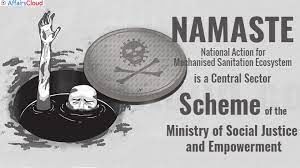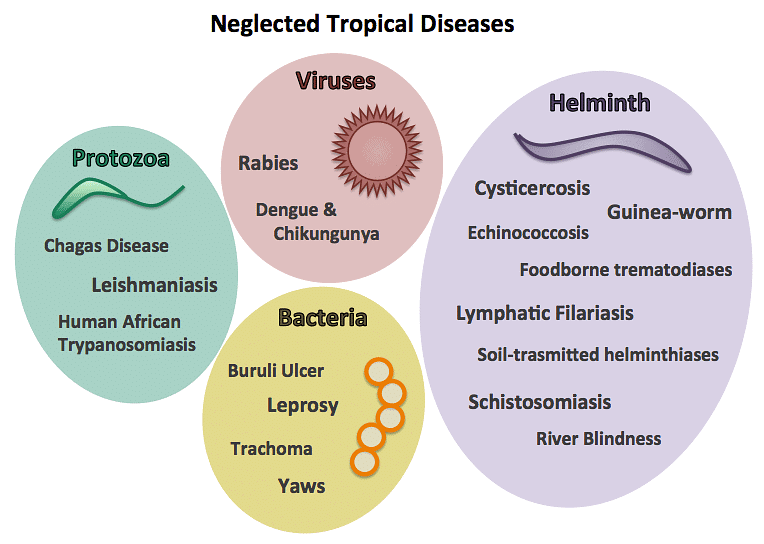Indian Society and Social Issues: February 2023 UPSC Current Affairs | Current Affairs & Hindu Analysis: Daily, Weekly & Monthly PDF Download
NAMASTE Scheme
Why in News?
Union Budget 2023-2024 has allocated nearly Rs 100 crore for the National Action for Mechanized Sanitation Ecosystem (NAMASTE) and the government is looking to enable 100% mechanical desludging of septic tanks and sewers in all cities and towns.
- The process of extending the Scheme to all the Urban Local Bodies (ULBs) of the country has been initiated.
What is the NAMASTE Scheme?
About:
It was launched in 2022 as a Central Sector Scheme.
- The scheme is being undertaken jointly by the Ministry of Housing and Urban Affairs and the Ministry of Social Justice & Empowerment (MoSJE) and aims to eradicate unsafe sewer and septic tank cleaning practices.
Objectives:
- Zero fatalities in sanitation work in India.
- All sanitation work is performed by skilled workers.
- No sanitation workers come in direct contact with human faecal matter.
- Sanitation workers are collectivised into Self Help Groups (SHGs) and are empowered to run sanitation enterprises.
- Strengthened supervisory and monitoring systems at National, State and Urban Local Body (ULB) levels to ensure enforcement and monitoring of safe sanitation work.
- Increased awareness among sanitation services seekers (individuals and institutions) to seek services from registered and skilled sanitation workers.
What are the Key Features of the Scheme to be Implemented in all ULBs?
- Identification: NAMASTE envisages identifying the Sewer/Septic Tank Workers (SSWs).
- Occupational Training and distribution of PPE Kits to SSWs.
- Assistance for Safety Devices to Sanitation Response Units (SRUs).
- Extending Health Insurance Scheme Benefits to identified SSWs and their families under the Ayushman Bharat- Pradhan Mantri Jan Arogya Yojana (AB-PMJAY).
- Livelihood Assistance: The Action Plan will promote mechanization and enterprise development by providing funding support and subsidy (capital +interest) to the sanitation workers, to procure sanitation related equipments.
- IEC (Information Education and Communication) Campaign: Massive campaigns would be undertaken jointly by the ULBs & NSKFDC (National Safai Karamcharis Finance & Development Corporation) to spread awareness about the interventions of NAMASTE.
What is Manual Scavenging?
- Manual scavenging is defined as “the removal of human excrement from public streets and dry latrines, cleaning septic tanks, gutters and sewers”.
- India banned the practice under the Prohibition of Employment as Manual Scavengers and their Rehabilitation Act, 2013 (PEMSR).
- The Act recognizes manual scavenging as a “dehumanizing practice.
What are the Steps taken to tackle the Menace of Manual Scavenging?
- The Prohibition of Employment as Manual Scavengers and their Rehabilitation (Amendment) Bill, 2020:
- It proposes to completely mechanise sewer cleaning, introduce ways for ‘on-site’ protection and provide compensation to manual scavengers in case of sewer deaths.
- It will be an amendment to The Prohibition of Employment as Manual Scavengers and their Rehabilitation Act, 2013.
- It is still awaiting cabinet approval.
- The Prohibition of Employment as Manual Scavengers and their Rehabilitation Act, 2013:
- Superseding the 1993 Act, the 2013 Act goes beyond prohibitions on dry latrines, and outlaws all manual excrement cleaning of insanitary latrines, open drains, or pits.
- The Building and Maintenance of Insanitary Latrines Act of 2013:
- It outlaws construction or maintenance of unsanitary toilets, and the hiring of anybody for their manual scavenging, as well as of hazardous cleaning of sewers and septic tanks.
- Prevention of Atrocities Act:
- In 1989, the Prevention of Atrocities Act became an integrated guard for sanitation workers, more than 90% people employed as manual scavengers belonged to the Scheduled Caste. This became an important landmark to free manual scavengers from designated traditional occupations.
- SC Judgment:
- In 2014, a Supreme Court order made it mandatory for the government to identify all those who died in sewage work since 1993 and provide Rs. 10 lakh each as compensation to their families.
Mission Shakti
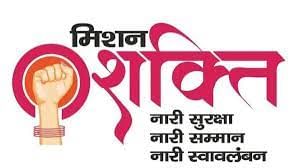
Why In News?

The Ministry of Women and Child Development has issued detailed guidelines for the ‘Mission Shakti' scheme.
About Mission Shakti
- The Government of India has launched 'Mission Shakti' - an integrated women empowerment programme as an umbrella scheme for the safety, security and empowerment of women for implementation during the 15th Finance Commission period 202l-22 to 2025-26.
- The norms of ‘Mission Shakti’ will be applicable with effect from 01.04.2022.
- ‘Mission Shakti’ is a scheme in mission mode aimed at strengthening interventions for women safety, security and empowerment.
Sub-schemes
- ‘Mission Shakti’ has two sub-schemes -
- 'Sambal' -the "Sambal" sub-scheme is for safety and security of women
- The components of 'Sambal' sub-scheme consist of erstwhile schemes of One Stop Centre (OSC), Women Helpline (WHL), Beti Bachao Beti Padhao (BBBP) with a new component of Nari Adalats - women's collectives to promote and facilitate alternative dispute resolution and gender justice in society and within families.
- 'Samarthya': It is for the empowerment of women.
- The components of 'Samarthya' sub-scheme consist of erstwhile schemes of Ujjwala, Swadhar Greh and Working Women Hostel have been included with modifications.
Objectives
- To realise the Government’s commitment for “women-led development? by addressing issues affecting women on a life-cycle continuum basis and by making them equal partners in nation-building through convergence and citizen-ownership.
- To make women economically empowered, exercising free choice over their minds and bodies in an atmosphere free from violence and threat.
- To reduce the care burden on women and increase female labour force participation by promoting skill development, capacity building, financial literacy, access to microcredit etc.
Increasing Cases of Suicides in Educational Hubs
Why in News?
The National Crime Records Bureau’s (NCRB’s) Accidental Deaths and Suicide in India (ADSI) report 2021 shows student suicides had gone up drastically during the Covid-19 pandemic in 2020 and 2021 and have been steadily rising in the last five years.
What is the Current Status of Suicides in Students?
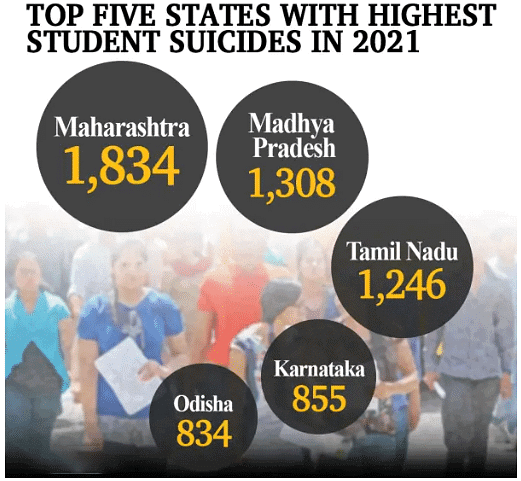
- Over 13,000 students died by in 2021 in India at the rate of more than 35 every day, a rise of 4.5% from the 12,526 deaths in 2020 with 864 out of 10,732 suicides being due to "failure in examination" according to the latest data as per NCRB’s ADSI report 2021.
- Since 1995, the country lost the highest number of students to suicides in 2021, while nearly 2 lakh of them have died by suicide in the past 25 years.
- The death by suicide of students has increased by 32.15% since 2017, when 9,905 students died by suicide.
- Maharashtra had the highest number of student suicides in 2021 with 1,834, followed by Madhya Pradesh and Tamil Nadu.
- The report also showed the percentage of women student suicide was at a five-year low of 43.49%, while men student suicides made up 56.51% of the total student suicides.
- In 2017, 4,711 women students died by suicide, while in 2021 such deaths increased to 5,693.
- As per Ministry of Education, 122 students from IITs, NITs, central universities and other central institutions died by suicide over 2014-21.
- 68 of 122 belonged to the scheduled castes (SC), scheduled tribes (ST) or other backward classes (OBC).
- Suicides are a growing concern in Kota, India, a hub for engineering and medical entrance exams preparation.
- As of January 2023, 22 students have died in Kota since 2022 and around 121 have died since 2011.
What are the Factors that Increase Suicide Risk?
- Academic Pressure:
- High expectations from parents, teachers and society can lead to excessive stress and pressure to perform well in exams.
- This pressure to succeed can be overwhelming for some students, leading to feelings of failure and hopelessness.
- Mental Health Issues:
- Mental health problems such as depression, anxiety, and bipolar disorder can contribute to student suicides.
- These conditions can be exacerbated by stress, loneliness, and lack of support.
- Isolation and Loneliness:
- Many students in educational hubs come from far away and live away from their families and friends.
- This can lead to feelings of isolation and loneliness, which can be particularly difficult to deal with in an unfamiliar and competitive environment.
- Financial Concerns:
- Financial difficulties, such as not being able to afford tuition fees or living expenses, can create a great deal of stress and worry for students.
- This can lead to feelings of hopelessness and desperation.
- Cyber Bullying:
- Cyber bullying and online harassment are becoming increasingly common and can contribute to student suicides.
- Cyber bullying can take many forms, such as harassment, cyberstalking, or bullying through social media.
- Substance Abuse:
- Substance abuse and alcohol abuse can contribute to student suicides. Substance abuse can lead to mental health problems, financial difficulties, and legal issues, all of which can be overwhelming for students.
- Relationship Problems:
- Relationship problems, such as break-ups, family conflicts, and friendship issues can also contribute to student suicides.
- These problems can be particularly difficult to deal with for students who are far from home and have limited support.
- Lack of Support:
- Many students in educational hubs are reluctant to reach out for help when they are struggling.
- This can be due to stigma surrounding mental health problems or a fear of being judged.
- This lack of support can lead to feelings of hopelessness and desperation.
What can be Done to Prevent Suicides?
- Improved Mental Health Services:
- Providing students with access to mental health services and resources such as counseling services, support groups, and psychiatric services can help prevent suicides.
- Also, schools and universities must train teachers, staff, and students in mental health first aid.
- Embracing Positive Attitude towards Mental Health:
- Positive attitudes towards mental health and help-seeking must also be promoted through open discussions about mental health and suicide.
- Focus on Overall Personality Development:
- By taking a holistic approach to personality development, educational institutions can create a supportive and inclusive environment that helps students thrive both academically and emotionally, and can play a critical role in preventing suicides.
- Encouraging Participation in Sports:
- Sports can play a role in preventing suicides in educational hubs by providing a positive outlet for stress and emotions, as well as increase self-esteem and confidence.
- Addressing the Socio-economic Issues:
- Socio-economic factors such as poverty, homelessness, and unemployment should be addressed to improve students' overall well-being and reduce stress, anxiety, and depression.
- Stricter Cyber Bullying Policies:
- Implementing stricter cyber bullying policies and cracking down on online harassment can help reduce the risk of student suicides.
- This may include monitoring social media sites, providing education about cyber bullying, and taking legal action against cyber bullies.
- Substance Abuse Prevention Programs:
- Implementing substance abuse prevention programs can help reduce the risk of student suicides.
- This may include educating students about the dangers of substance abuse, providing support for those struggling with addiction, and taking steps to reduce access to drugs and alcohol.
- Building Positive Relationships:
- Encouraging students to build positive relationships and connections, offering relationship counseling services, and encouraging students to reach out for help can help reduce the risk of suicide.
- Family Support:
- Providing students with support from their families can help reduce the risk of suicide.
- This may include offering support and resources for families, and encouraging students to maintain contact with their families.
What are Related Initiatives to Reduce Suicides?
- Global Initiatives:
- World Suicide Prevention Day (WSPD): Observed on 10th of September every year, WSPD was established in 2003 by the International Association for Suicide Prevention (IASP) in conjunction with the WHO. It focuses attention on the issue, reduces stigma and raises awareness among organizations, government, and the public, giving a singular message that suicide can be prevented.
- “Creating hope through action” is the triennial theme for the WSPD from 2021 - 2023. This theme is a reminder that there is an alternative to suicide and aims to inspire confidence and light in all of us.
- World Mental Health Day: 10th October is celebrated as World Mental Health Day, every year. The overall objective of World Mental Health Day is to raise awareness of mental health issues around the world and to mobilize efforts in support of mental health.
- The theme of World Mental Health Day 2022 is “Making Mental Health & Well-Being for All a Global Priority”.
Indian Initiatives:
- Mental Healthcare Act (MHA), 2017:
- MHA 2017 aims to provide mental healthcare services for persons with mental illness.
KIRAN:
- The Ministry of Social Justice and Empowerment has launched a 24/7 toll-free helpline “KIRAN” to provide support to people facing anxiety, stress, depression, suicidal thoughts and other mental health concerns.
Manodarpan Initiative:
- Manodarpan is an initiative of the Ministry of Education under Atmanirbhar Bharat Abhiyan.
- It is aimed to provide psychosocial support to students, family members and teachers for their mental health and well-being during the times of Covid-19.
- National Suicide Prevention Strategy:
- Announced in 2023, National Suicide Prevention Strategy is the first of its kind in the country, with time-bound action plans and multi-sectoral collaborations to achieve reduction in suicide mortality by 10% by 2030.
- The strategy is in line with the World Health Organisation’s South East-Asia Region Strategy for suicide prevention.
Its objectives are:
- The strategy broadly seeks to establish effective surveillance mechanisms for suicide within the next three years.
- It seeks to establish psychiatric outpatient departments that will provide suicide prevention services through the District Mental Health Programme in all districts within the next five years.
- It also aims to integrate a mental well-being curriculum in all educational institutions within the next eight years.
- It envisages developing guidelines for responsible media reporting of suicides, and restricting access to means of suicide.
Trends in Maternal Mortality: UN
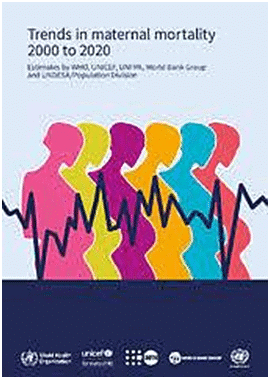 Why in News?
Why in News?
- The Maternal Mortality Ratio (MMR) — deaths per lakh live births — in the region was at a dangerous high of 545, many times greater than the world average of 223.
What are the Key Findings of the Report?
- Statistics:
- Every two minutes, a woman dies during pregnancy or childbirth, revealing alarming setbacks for women’s health over recent years, as maternal deaths either increased or stagnated in nearly all regions of the world.
- There were an estimated 287,000 maternal deaths worldwide in 2020, which is a slight decrease from 309,000 in 2016 when the UN’s Sustainable Development Goals (SDGs) came into effect.
- Although there has been significant progress in reducing maternal deaths between 2000 and 2015, gains largely stalled, or in some cases even reversed, after this point.
- MMR:
- In 2020, about 70% of all maternal deaths were in sub-Saharan Africa.
- The top three sub-regions in the world with a high or very high MMR were found in sub-Saharan Africa,
- Western Africa at 754, middle Africa at 539 and eastern Africa at 351.
- On the country level, a similar trend was seen with South Sudan (1,223), Chad (1,063) and Nigeria (1,047) recording an extremely high — greater than 1,000 — MMR.
- With approximately 82,000 maternal deaths in 2020, Nigeria accounted for over a quarter (28.5%) of all estimated global maternal deaths in the pandemic year.
- From 2000 to 2020, declines in the MMR stagnated in sub-Saharan Africa, northern Africa, Oceania (excluding Australia and New Zealand) and western Asia, and eastern and south-eastern Asia.
- Causes of Maternal Deaths:
- Severe bleeding, high blood pressure, pregnancy-related infections, complications from unsafe abortion, and underlying conditions that can be aggravated by pregnancy (such as HIV/AIDS and malaria) are the leading causes of maternal deaths.
- Globally, 1,878 HIV-related indirect maternal deaths were recorded, of which 1,738 (around 92.5%) were in sub-Saharan Africa.
- Healthcare Gaps:
- Roughly a third of women do not have even four of a recommended eight antenatal checks or receive essential postnatal care, while some 270 million women lack access to modern family planning methods.
- Risks:
- Inequities related to income, education, race or ethnicity further increase risks for marginalized pregnant women, who have the least access to essential maternity care but are most likely to experience underlying health problems in pregnancy.
What are the Findings Related to India?
- India recorded the second highest number of maternal deaths in 2020, coming second at 24,000 to only Nigeria.
- However, there has been an overall reduction of 73.5% in MMR in India, between 2000 and 2020.
- In 2020, India’s MMR stood at 103, a vast improvement from 384 at the turn of the century.
- In comparison, other developing countries like Argentina (45 in 2020), Bhutan (60), Brazil (72), Kyrgyzstan (50) and Philippines (78) have performed better than India.
What are the Recommendations?
- More Resilient Health System:
- With immediate action, more investments in primary health care and stronger, more resilient health systems, we can save lives, improve health and well-being, and advance the rights of and opportunities for women and adolescents.
- Community-centered Health Care:
- Community-centered primary health care can meet the needs of women, children and adolescents and enable equitable access to critical services such as assisted births and pre- and postnatal care, childhood vaccinations, nutrition and family planning.
- Control over Reproductive Health:
- Exercising control over their reproductive health, particularly decisions about if and when to have children, is critical to ensure that women can plan and space childbearing and protect their health.
- National and International Efforts:
- Ending preventable maternal deaths and providing universal access to quality maternal health care require sustained national and international efforts and unwavering commitments, particularly for the most vulnerable populations.
- It is our collective responsibility to ensure that every mother, everywhere, survives childbirth, so that she and her children can thrive.
- Meeting Global Targets:
- The world must significantly accelerate progress to meet global targets for reducing maternal deaths, or else risk the lives of over 1 million more women by 2030.
- The SDG target for maternal deaths is for a global MMR of less than 70 maternal deaths per 100,000 live births by 2030.
Neglected Tropical Diseases
Context
- Recently, the “Global report on neglected tropical diseases 2023” was published on World NTD Day- January 30th by WHO.
Report highlights
- Global burdon of NTDs:
- According to the report, Neglected Tropical Diseases (NTD) continue to disproportionately impact the most impoverished members of the international community, living in areas with
- inadequate water safety, sanitation and access to health care.
- Some 16 countries accounted for 80 percent of the global NTD burden.
- Globally, nearly 1.65 billion people were estimated to require treatment for at least one NTD, the report highlighted.
- Impact of COVID:
- Report highlighted the advancement and challenges in delivering NTD care worldwide against a backdrop of COVID-19-related disruptions.
- It also highlighted the tremendous effects COVID-19 had on community-based initiatives, access to healthcare facilities and healthcare goods supply chains.
- As a result, between 2019 and 2020, 34 percent fewer persons received treatment for NTDs.
- Accomplishments:
- Despite challenges, some accomplishments were made on this front in 2021-2022.
- More than one billion people have been treated for NTDs annually between 2016 and 2019, thanks to mass treatment initiatives.
- And in 2021, 25 percent fewer people needed treatments against NTDs than in 2010.
- Need for efforts and investments:
- It underscored greater efforts and investments required to reverse delays and accelerate progress towards the NTD road map targets by 2030.
Report Suggestions
- Collaborations and partnerships:
- WHO urged multi-sectoral collaboration and partnerships to achieve these targets.
- Closing the gaps:
- WHO called on additional partners and funders to step up and close the gaps preventing the full-scale implementation of NTD actions at the international and local levels.
- WHO’s initiatives:
- Over 100 scientific recommendations, tools, and other information products were produced as a result of WHO’s NTD efforts in 2021 and 2022 to support the international NTD community, particularly poor countries.
- The global health body launched an NTD channel with 36 training courses on 19 different topics for healthcare professionals.
More about the Neglected Tropical Diseases (NTD)
About:
- NTDs are a diverse group of conditions mainly prevalent in tropical areas caused by various pathogens, including viruses, bacteria, parasites, fungi and toxins.
Dominant regions:
- They are common in low-income populations in developing regions of Africa, Asia, and the Americas.
Prioritization by WHO:
- Twenty neglected tropical diseases are prioritized by the World Health Organization (WHO).
- Chromoblastomycosis and other deep mycoses, scabies and other ectoparasites, and snakebite envenomation were added to the list in 2017.
Global issue:
- These diseases are common in 149 countries, affecting more than 1.4 billion people (including more than 500 million children)and costing developing economies billions of dollars every year.
- They resulted in 142,000 deaths in 2013—down from 204,000 deaths in 1990.
NTD’s in India
- Neglected tropical diseases (NTDs) continue to pose a significant health burden on some of the most disadvantaged communities in India.
- India has the world's largest absolute burden of at least 10 major NTDs, including hookworm, dengue, lymphatic filariasis, leprosy, visceral leishmaniasis or kala-azar and rabies.
- Lymphatic Filariasis is endemic in 328 districts across 21 states/Union territories.
- Kala-Azar is endemic in 54 districts across four states of India and together, these diseases affect 650 million and 140 million people in the country, respectively.
- It is difficult to estimate the actual burden of NTDs in India as there is no single organisation or government agency which has been given this mandate.
Government Initiatives
- The Government of India is 100 percent committed to ending NTDs like Lymphatic Filariasis and Kala-Azar, in line with global elimination and control targets.
Preventive methods:
- Preventive methods like Mass Drug Administration (MDA) rounds are periodically deployed in endemic areas during which anti-filarial medicines are provided free-of-cost to at-risk communities.
Vector-control measures:
- Vector-control measures like Indoor Residual Spraying rounds are undertaken in endemic areas to prevent sandfly breeding.
- The government also supports morbidity management and disability prevention for those affected by lymphoedema and hydrocele.
Target-oriented elimination:
- Some of the vector-borne diseases (mosquito and sandfly) have been targeted for elimination or prevention by the National Centre for Vector Borne Disease Control and Programme for Leprosy and Soil Transmitted Helminths.
Wage compensation schemes:
- State and central governments have also introduced wage compensation schemes for those suffering from Kala-Azar and its sequela (a condition which is the consequence of a previous disease or injury) known as Post-Kala Azar Dermal Leishmaniasis.
Way ahead
- We have the tools and the know-how not just to save lives and prevent suffering but to free entire communities and countries of these diseases.
- It’s time to act now, act together, and invest in NTDs.
- India is poised to emerge as a global leader in the battle against NTDs, but success in this decade will demand bolder action.
- As India stands firm on its commitment to eliminate NTDs, multi-stakeholder and cross-sectoral partnerships and collaboration will continue to play a central role in sustaining the momentum gained.
- An integrated approach to improving access to quality healthcare, water, sanitation, hygiene, addressing climate change and ensuring gender equity, mental health and well-being must lie at the core of eliminating these diverse NTDs.
Children have a Right to protect their Genetic Information from DNA tests: SC
Context
The Supreme Court of India has ruled that children have the right to protect their genetic information from being revealed in DNA tests without their consent.
Right to protect Genetic Information
- The right to protect genetic information is a fundamental right that recognizes an individual’s autonomy and control over their own personal and intimate genetic data.
- It allows individuals to make informed decisions about their health, privacy, and identity.
- In India, the Supreme Court has also held that children have the right to protect their genetic information from DNA testing in divorce proceedings, as it is part of their fundamental right to privacy.
- This is guaranteed under Article 21 of Indian Constitution.
- This right is recognized under various international human rights instruments, including the Universal Declaration of Human Rights and the International Covenant on Civil and Political Rights.
Key takeaways from the Judgment
The court ruled that-
- Genetic information is personal and intimate
- Children have the right to privacy and bodily integrity
- Children are not to be regarded like material objects and should not become the focal point of the battle between spouses
- Allowing DNA tests would also harm the reputation and dignity of the mother
Basis of this judgment
The court drew attention to the rights of privacy, autonomy and identity recognised under the United Nations’ Convention on the Rights of the Child.
It acknowledged the control that individuals, including children, have over their own personal boundaries and the means by which they define who they are in relation to other people.
Children are not to be deprived of this entitlement to influence and understand their sense of self simply by virtue of being children.
How can one get the tests done?
- Family courts should direct for a DNA test only in expedient situations and in the interest of justice, as a last resort, said the judgment.
- This should be practised as the option of last resort.
Special Marriage Act, 1954

Why in News?

Several interfaith couples have chosen to marry under a secular personal law through the Special Marriage Act, 1954.
What is the Special Marriage Act, of 1954?
- The Special Marriage Act of 1954 (SMA) provides an alternate route to religious laws for marriage It governs a civil marriage where the state sanctions the marriage rather than the religion.
Need for this Act
- Issues of personal law such as marriage, divorce, adoption are governed by religious laws that are codified. These laws, such as the Muslim Marriage Act, 1954, and the Hindu Marriage Act, 1955, require either spouse to convert to the religion of the other before marriage.
- SMA enables marriage between inter-faith or inter-caste couples without them giving up their religious identity or resorting to conversion.
Concerns
- The provisions relating to notice, publication and objection have rendered it difficult for many people intending to solemnize inter-faith marriages.
- In 2009, the Delhi High Court, underlining the right to privacy, struck down the practice of posting the notice of intended marriage under the SMA to the residential addresses of both parties.
- In January 2021, the Allahabad High Court ruled that couples seeking to solemnize their marriage under the Special Marriage Act, 1954 can choose not to publish the mandatory 30-day notice of their intention to marry.
Way ahead
- The state needs to focus on promoting and protecting the rights of women within marriage and aim for a more equal, progressive law.
|
44 videos|5271 docs|1113 tests
|
FAQs on Indian Society and Social Issues: February 2023 UPSC Current Affairs - Current Affairs & Hindu Analysis: Daily, Weekly & Monthly
| 1. What is the NAMASTE Scheme? |  |
| 2. What is Mission Shakti? |  |
| 3. What are the trends in maternal mortality according to the UN? |  |
| 4. What are Neglected Tropical Diseases (NTDs)? |  |
| 5. What is the Special Marriage Act, 1954? |  |


